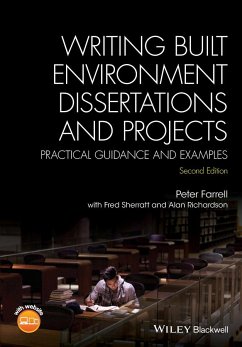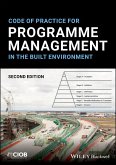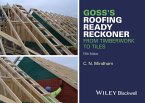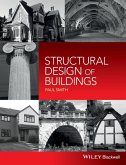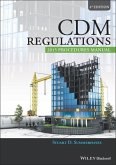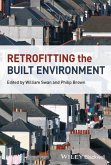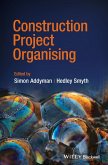Peter Farrell, Fred Sherratt, Alan Richardson
Writing Built Environment Dissertations and Projects
Practical Guidance and Examples
Peter Farrell, Fred Sherratt, Alan Richardson
Writing Built Environment Dissertations and Projects
Practical Guidance and Examples
- Broschiertes Buch
- Merkliste
- Auf die Merkliste
- Bewerten Bewerten
- Teilen
- Produkt teilen
- Produkterinnerung
- Produkterinnerung
Writing Built Environment Dissertations and Projects will help you to write a good dissertation or project by giving you a good understanding of what should be included, and showing you how to use data collection and analysis tools in the course of your research. _ Addresses prominent weaknesses in under-graduate dissertations including weak data collection; superficial analysis and poor reliability and validity _ Includes many more in-depth examples making it easy to understand and assimilate the concepts presented _ Issues around study skills and ethics are embedded throughout the book and…mehr
Andere Kunden interessierten sich auch für
![Code of Practice for Programme Management in the Built Environment Code of Practice for Programme Management in the Built Environment]() CIOB (The Chartered Institute of Building)Code of Practice for Programme Management in the Built Environment62,99 €
CIOB (The Chartered Institute of Building)Code of Practice for Programme Management in the Built Environment62,99 €![Goss's Roofing Ready Reckoner Goss's Roofing Ready Reckoner]() C. N. MindhamGoss's Roofing Ready Reckoner32,99 €
C. N. MindhamGoss's Roofing Ready Reckoner32,99 €![Gas Installation Technology Gas Installation Technology]() Andrew S. BurchamGas Installation Technology36,99 €
Andrew S. BurchamGas Installation Technology36,99 €![Structural Design of Buildings Structural Design of Buildings]() Paul SmithStructural Design of Buildings70,99 €
Paul SmithStructural Design of Buildings70,99 €![CDM Regulations 2015 Procedures Manual CDM Regulations 2015 Procedures Manual]() Stuart D. SummerhayesCDM Regulations 2015 Procedures Manual106,99 €
Stuart D. SummerhayesCDM Regulations 2015 Procedures Manual106,99 €![Retrofitting the Built Environment Retrofitting the Built Environment]() Retrofitting the Built Environment119,99 €
Retrofitting the Built Environment119,99 €![Construction Project Organising Construction Project Organising]() Construction Project Organising129,99 €
Construction Project Organising129,99 €-
-
-
Writing Built Environment Dissertations and Projects will help you to write a good dissertation or project by giving you a good understanding of what should be included, and showing you how to use data collection and analysis tools in the course of your research.
_ Addresses prominent weaknesses in under-graduate dissertations including weak data collection; superficial analysis and poor reliability and validity
_ Includes many more in-depth examples making it easy to understand and assimilate the concepts presented
_ Issues around study skills and ethics are embedded throughout the book and the many examples encourage you to consider the concepts of reliability and validity
_ Second edition includes a new chapter on laboratory based research projects
_ Supporting website with sample statistical calculations and additional examples from a wider range of built environment subjects
_ Addresses prominent weaknesses in under-graduate dissertations including weak data collection; superficial analysis and poor reliability and validity
_ Includes many more in-depth examples making it easy to understand and assimilate the concepts presented
_ Issues around study skills and ethics are embedded throughout the book and the many examples encourage you to consider the concepts of reliability and validity
_ Second edition includes a new chapter on laboratory based research projects
_ Supporting website with sample statistical calculations and additional examples from a wider range of built environment subjects
Produktdetails
- Produktdetails
- Verlag: Wiley & Sons / Wiley-Blackwell
- Artikelnr. des Verlages: 1W118921920
- 2. Aufl.
- Seitenzahl: 368
- Erscheinungstermin: 27. Mai 2016
- Englisch
- Abmessung: 246mm x 171mm x 19mm
- Gewicht: 710g
- ISBN-13: 9781118921920
- ISBN-10: 1118921925
- Artikelnr.: 44708454
- Herstellerkennzeichnung
- Libri GmbH
- Europaallee 1
- 36244 Bad Hersfeld
- gpsr@libri.de
- Verlag: Wiley & Sons / Wiley-Blackwell
- Artikelnr. des Verlages: 1W118921920
- 2. Aufl.
- Seitenzahl: 368
- Erscheinungstermin: 27. Mai 2016
- Englisch
- Abmessung: 246mm x 171mm x 19mm
- Gewicht: 710g
- ISBN-13: 9781118921920
- ISBN-10: 1118921925
- Artikelnr.: 44708454
- Herstellerkennzeichnung
- Libri GmbH
- Europaallee 1
- 36244 Bad Hersfeld
- gpsr@libri.de
Peter Farrell is a Reader in Construction Management at the University of Bolton, UK, and programme leader for the university¿s MSc in Construction Project Management. Fred Sherratt is a Senior Lecturer in Construction Management at Anglia Ruskin University, UK. Alan Richardson is a Reader in Civil Engineering at Northumbria University, UK and programme leader for the BEng in Civil Engineering.
Author biographies ix
Preface x
About the companion website xii
1 Introduction 1
1.1 Introduction 1
1.2 Terminology; nomenclature 2
1.3 Document structure 3
1.4 Possible subject areas for your research 7
1.5 Professional bodies and the non?]technical or technical dissertation or project 8
1.6 Qualitative or quantitative analysis? 10
1.7 The student/supervisor relationship and time management 14
1.8 Ethical compliance and risk assessments 17
1.9 House style or style guide 22
1.10 Writing style 23
1.11 Proofreading 27
1.12 Extra support? 29
1.13 A research proposal 29
1.14 A viva or viva voce 30
Summary 31
References 31
2 The introduction chapter to the dissertation or project 33
2.1 Introduction contents 33
2.2 Articulation or description of the problem and provisional objectives 35
Summary of this chapter 37
References 38
3 Review of theory and the literature 39
3.1 Introduction 39
3.2 Style and contents of a literature review 41
3.3 Judgements or opinions? 43
3.4 Sources of data 44
3.5 Methods of finding the literature 48
3.6 Embedding theory in dissertations and projects 49
3.7 Referencing as evidence of reading 53
3.8 Citing literature sources in the narrative of your work 54
3.9 References or bibliography or both? 58
3.10 Common mistakes by students 59
3.11 Using software to help with references 60
3.12 Avoiding the charge of plagiarism 62
Summary of this chapter 64
References 64
4 Research goals and their measurement 67
4.1 Introduction 68
4.2 Aim 70
4.3 Research questions 71
4.4 Objectives 71
4.5 Variables 74
4.6 A hypothesis with one variable 75
4.7 A hypothesis with two variables: independent and dependent 77
4.8 Writing the hypothesis: nulls and tails - a matter of semantics 81
4.9 'Lots' of variables at large, intervening variables 83
4.10 Ancillary or subject variables 83
4.11 No relationship between the IV and the DV 88
4.12 Designing measurement instruments; use authoritative tools and adapt the work of others 89
4.13 Levels of measurement 93
4.14 Examples of categorical or nominal data in construction 95
4.15 Examples of ordinal data in construction 96
4.16 Examples of interval and ratio data in construction 97
4.17 Types of data 98
4.18 Money and CO2 as variables 102
4.19 Three objectives, each with an IV and DV: four variables to measure 103
4.20 Summarising research goals; variables and their definition 104
Summary of this chapter 105
References 105
5 The Methodology chapter; analysis, results and findings 107
5.1 Introduction 107
5.2 Approaches to collecting data 110
5.3 Data measuring and collection 112
5.4 Issues mostly relevant to just questionnaires 120
5.5 Ranking studies 129
5.6 Other analytical tools 131
5.7 Incorporating reliability and validity 132
5.8 Analysis, results and findings 137
Summary of this chapter 138
References 139
6 Laboratory experiments 140
6.1 Introduction 141
6.2 Test methodology 142
6.3 Sourcing test materials 143
6.4 Reliability and validity of findings 143
6.5 Sample size 145
6.6 Laboratory recording procedures 145
6.7 Dissertation/project writing (introduction, methodology and results) 146
6.8 Health and safety in the laboratory; COSHH and risk assessments 149
6.9 Role of the supervisor 151
6.10 Possible research topics for technical dissertations or projects, construction and civil engineering 153
6.11 Examples of research proposals 153
6.12 Research objectives and sample findings by the author 154
Bibliography 163
7 Qualitative data analysis 165
7.1 Introduction 165
7.2 The process of qualitative data collection 166
7.3 Steps in the analytical process 168
Summary of this chapter 175
References 176
8 Quantitative data ana
Preface x
About the companion website xii
1 Introduction 1
1.1 Introduction 1
1.2 Terminology; nomenclature 2
1.3 Document structure 3
1.4 Possible subject areas for your research 7
1.5 Professional bodies and the non?]technical or technical dissertation or project 8
1.6 Qualitative or quantitative analysis? 10
1.7 The student/supervisor relationship and time management 14
1.8 Ethical compliance and risk assessments 17
1.9 House style or style guide 22
1.10 Writing style 23
1.11 Proofreading 27
1.12 Extra support? 29
1.13 A research proposal 29
1.14 A viva or viva voce 30
Summary 31
References 31
2 The introduction chapter to the dissertation or project 33
2.1 Introduction contents 33
2.2 Articulation or description of the problem and provisional objectives 35
Summary of this chapter 37
References 38
3 Review of theory and the literature 39
3.1 Introduction 39
3.2 Style and contents of a literature review 41
3.3 Judgements or opinions? 43
3.4 Sources of data 44
3.5 Methods of finding the literature 48
3.6 Embedding theory in dissertations and projects 49
3.7 Referencing as evidence of reading 53
3.8 Citing literature sources in the narrative of your work 54
3.9 References or bibliography or both? 58
3.10 Common mistakes by students 59
3.11 Using software to help with references 60
3.12 Avoiding the charge of plagiarism 62
Summary of this chapter 64
References 64
4 Research goals and their measurement 67
4.1 Introduction 68
4.2 Aim 70
4.3 Research questions 71
4.4 Objectives 71
4.5 Variables 74
4.6 A hypothesis with one variable 75
4.7 A hypothesis with two variables: independent and dependent 77
4.8 Writing the hypothesis: nulls and tails - a matter of semantics 81
4.9 'Lots' of variables at large, intervening variables 83
4.10 Ancillary or subject variables 83
4.11 No relationship between the IV and the DV 88
4.12 Designing measurement instruments; use authoritative tools and adapt the work of others 89
4.13 Levels of measurement 93
4.14 Examples of categorical or nominal data in construction 95
4.15 Examples of ordinal data in construction 96
4.16 Examples of interval and ratio data in construction 97
4.17 Types of data 98
4.18 Money and CO2 as variables 102
4.19 Three objectives, each with an IV and DV: four variables to measure 103
4.20 Summarising research goals; variables and their definition 104
Summary of this chapter 105
References 105
5 The Methodology chapter; analysis, results and findings 107
5.1 Introduction 107
5.2 Approaches to collecting data 110
5.3 Data measuring and collection 112
5.4 Issues mostly relevant to just questionnaires 120
5.5 Ranking studies 129
5.6 Other analytical tools 131
5.7 Incorporating reliability and validity 132
5.8 Analysis, results and findings 137
Summary of this chapter 138
References 139
6 Laboratory experiments 140
6.1 Introduction 141
6.2 Test methodology 142
6.3 Sourcing test materials 143
6.4 Reliability and validity of findings 143
6.5 Sample size 145
6.6 Laboratory recording procedures 145
6.7 Dissertation/project writing (introduction, methodology and results) 146
6.8 Health and safety in the laboratory; COSHH and risk assessments 149
6.9 Role of the supervisor 151
6.10 Possible research topics for technical dissertations or projects, construction and civil engineering 153
6.11 Examples of research proposals 153
6.12 Research objectives and sample findings by the author 154
Bibliography 163
7 Qualitative data analysis 165
7.1 Introduction 165
7.2 The process of qualitative data collection 166
7.3 Steps in the analytical process 168
Summary of this chapter 175
References 176
8 Quantitative data ana
Author biographies ix
Preface x
About the companion website xii
1 Introduction 1
1.1 Introduction 1
1.2 Terminology; nomenclature 2
1.3 Document structure 3
1.4 Possible subject areas for your research 7
1.5 Professional bodies and the non?]technical or technical dissertation or project 8
1.6 Qualitative or quantitative analysis? 10
1.7 The student/supervisor relationship and time management 14
1.8 Ethical compliance and risk assessments 17
1.9 House style or style guide 22
1.10 Writing style 23
1.11 Proofreading 27
1.12 Extra support? 29
1.13 A research proposal 29
1.14 A viva or viva voce 30
Summary 31
References 31
2 The introduction chapter to the dissertation or project 33
2.1 Introduction contents 33
2.2 Articulation or description of the problem and provisional objectives 35
Summary of this chapter 37
References 38
3 Review of theory and the literature 39
3.1 Introduction 39
3.2 Style and contents of a literature review 41
3.3 Judgements or opinions? 43
3.4 Sources of data 44
3.5 Methods of finding the literature 48
3.6 Embedding theory in dissertations and projects 49
3.7 Referencing as evidence of reading 53
3.8 Citing literature sources in the narrative of your work 54
3.9 References or bibliography or both? 58
3.10 Common mistakes by students 59
3.11 Using software to help with references 60
3.12 Avoiding the charge of plagiarism 62
Summary of this chapter 64
References 64
4 Research goals and their measurement 67
4.1 Introduction 68
4.2 Aim 70
4.3 Research questions 71
4.4 Objectives 71
4.5 Variables 74
4.6 A hypothesis with one variable 75
4.7 A hypothesis with two variables: independent and dependent 77
4.8 Writing the hypothesis: nulls and tails - a matter of semantics 81
4.9 'Lots' of variables at large, intervening variables 83
4.10 Ancillary or subject variables 83
4.11 No relationship between the IV and the DV 88
4.12 Designing measurement instruments; use authoritative tools and adapt the work of others 89
4.13 Levels of measurement 93
4.14 Examples of categorical or nominal data in construction 95
4.15 Examples of ordinal data in construction 96
4.16 Examples of interval and ratio data in construction 97
4.17 Types of data 98
4.18 Money and CO2 as variables 102
4.19 Three objectives, each with an IV and DV: four variables to measure 103
4.20 Summarising research goals; variables and their definition 104
Summary of this chapter 105
References 105
5 The Methodology chapter; analysis, results and findings 107
5.1 Introduction 107
5.2 Approaches to collecting data 110
5.3 Data measuring and collection 112
5.4 Issues mostly relevant to just questionnaires 120
5.5 Ranking studies 129
5.6 Other analytical tools 131
5.7 Incorporating reliability and validity 132
5.8 Analysis, results and findings 137
Summary of this chapter 138
References 139
6 Laboratory experiments 140
6.1 Introduction 141
6.2 Test methodology 142
6.3 Sourcing test materials 143
6.4 Reliability and validity of findings 143
6.5 Sample size 145
6.6 Laboratory recording procedures 145
6.7 Dissertation/project writing (introduction, methodology and results) 146
6.8 Health and safety in the laboratory; COSHH and risk assessments 149
6.9 Role of the supervisor 151
6.10 Possible research topics for technical dissertations or projects, construction and civil engineering 153
6.11 Examples of research proposals 153
6.12 Research objectives and sample findings by the author 154
Bibliography 163
7 Qualitative data analysis 165
7.1 Introduction 165
7.2 The process of qualitative data collection 166
7.3 Steps in the analytical process 168
Summary of this chapter 175
References 176
8 Quantitative data ana
Preface x
About the companion website xii
1 Introduction 1
1.1 Introduction 1
1.2 Terminology; nomenclature 2
1.3 Document structure 3
1.4 Possible subject areas for your research 7
1.5 Professional bodies and the non?]technical or technical dissertation or project 8
1.6 Qualitative or quantitative analysis? 10
1.7 The student/supervisor relationship and time management 14
1.8 Ethical compliance and risk assessments 17
1.9 House style or style guide 22
1.10 Writing style 23
1.11 Proofreading 27
1.12 Extra support? 29
1.13 A research proposal 29
1.14 A viva or viva voce 30
Summary 31
References 31
2 The introduction chapter to the dissertation or project 33
2.1 Introduction contents 33
2.2 Articulation or description of the problem and provisional objectives 35
Summary of this chapter 37
References 38
3 Review of theory and the literature 39
3.1 Introduction 39
3.2 Style and contents of a literature review 41
3.3 Judgements or opinions? 43
3.4 Sources of data 44
3.5 Methods of finding the literature 48
3.6 Embedding theory in dissertations and projects 49
3.7 Referencing as evidence of reading 53
3.8 Citing literature sources in the narrative of your work 54
3.9 References or bibliography or both? 58
3.10 Common mistakes by students 59
3.11 Using software to help with references 60
3.12 Avoiding the charge of plagiarism 62
Summary of this chapter 64
References 64
4 Research goals and their measurement 67
4.1 Introduction 68
4.2 Aim 70
4.3 Research questions 71
4.4 Objectives 71
4.5 Variables 74
4.6 A hypothesis with one variable 75
4.7 A hypothesis with two variables: independent and dependent 77
4.8 Writing the hypothesis: nulls and tails - a matter of semantics 81
4.9 'Lots' of variables at large, intervening variables 83
4.10 Ancillary or subject variables 83
4.11 No relationship between the IV and the DV 88
4.12 Designing measurement instruments; use authoritative tools and adapt the work of others 89
4.13 Levels of measurement 93
4.14 Examples of categorical or nominal data in construction 95
4.15 Examples of ordinal data in construction 96
4.16 Examples of interval and ratio data in construction 97
4.17 Types of data 98
4.18 Money and CO2 as variables 102
4.19 Three objectives, each with an IV and DV: four variables to measure 103
4.20 Summarising research goals; variables and their definition 104
Summary of this chapter 105
References 105
5 The Methodology chapter; analysis, results and findings 107
5.1 Introduction 107
5.2 Approaches to collecting data 110
5.3 Data measuring and collection 112
5.4 Issues mostly relevant to just questionnaires 120
5.5 Ranking studies 129
5.6 Other analytical tools 131
5.7 Incorporating reliability and validity 132
5.8 Analysis, results and findings 137
Summary of this chapter 138
References 139
6 Laboratory experiments 140
6.1 Introduction 141
6.2 Test methodology 142
6.3 Sourcing test materials 143
6.4 Reliability and validity of findings 143
6.5 Sample size 145
6.6 Laboratory recording procedures 145
6.7 Dissertation/project writing (introduction, methodology and results) 146
6.8 Health and safety in the laboratory; COSHH and risk assessments 149
6.9 Role of the supervisor 151
6.10 Possible research topics for technical dissertations or projects, construction and civil engineering 153
6.11 Examples of research proposals 153
6.12 Research objectives and sample findings by the author 154
Bibliography 163
7 Qualitative data analysis 165
7.1 Introduction 165
7.2 The process of qualitative data collection 166
7.3 Steps in the analytical process 168
Summary of this chapter 175
References 176
8 Quantitative data ana

